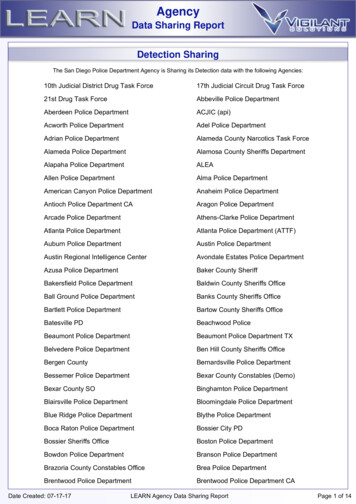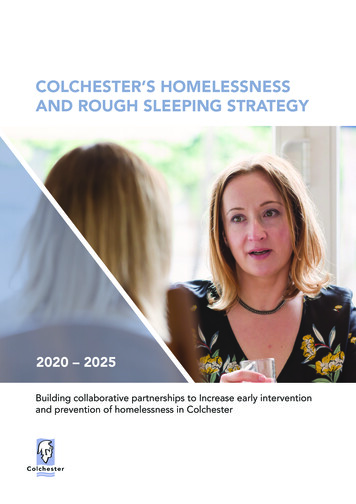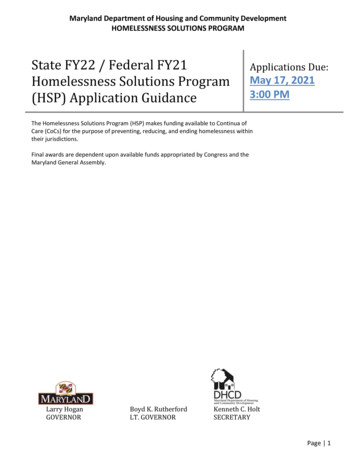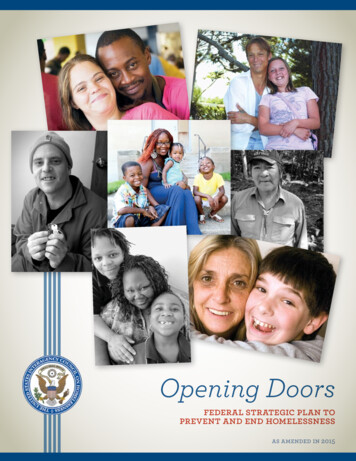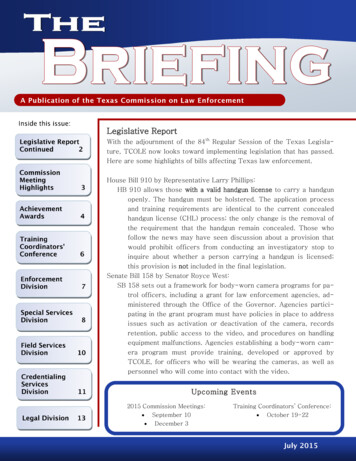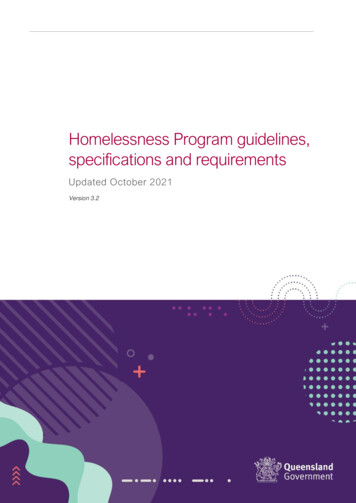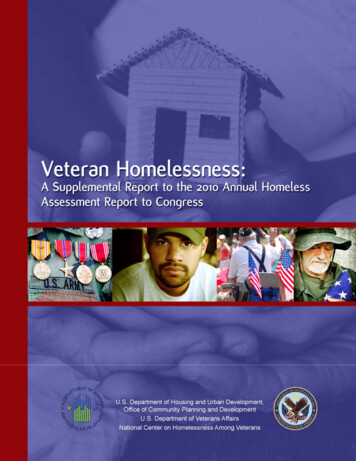
Transcription
CRITICAL ISSUES IN POLICING SERIESThe Police Responseto Homelessness
CRITICAL ISSUES IN POLICING SERIESThe Police Response toHomelessnessJune 2018
This publication was supported by the Motorola Solutions Foundation. The points of viewexpressed herein are the authors’ and do not necessarily represent the opinions of the MotorolaSolutions Foundation or all Police Executive Research Forum members.Police Executive Research Forum, Washington, D.C. 20036Copyright 2018 by Police Executive Research ForumAll rights reservedPrinted in the United States of AmericaISBN: 978-1-934485-43-9Graphic design by Dave Williams.Text photos by Sarah Mostyn, PERF.Cover photo credits, from upper left, clockwise: NYPD Officer Lawrence DePrimo offers a new pair of boots he purchased for a homelessman. Photo by Jennifer Foster. Hillsborough County, FL Sheriff’s Deputy Linda Ruggerio shares her lunch with a younghomeless man. Photo by Hillsborough County Sheriff’s Office. Miami Beach, FL police officers deliver mosquito repellent to community members. Photo byValerie Navarrete. Santa Cruz, CA police officers conducting a survey of homeless persons in order to gatherinformation and direct individuals to services. Photo by Santa Cruz Police Dept. Pinellas County Sheriff’s Office deputies and employees of Safe Harbor, a homeless shelterand jail diversion created by the Sheriff’s Office. See pp. 12-13 of this report. Photo by PCSO.
ContentsAcknowledgments.1The Police Response to Homelessness:Problem-Solving, Innovation, and Partnerships. 3By Chuck WexlerSidebar: Pinellas County Sheriff ’s Office Opens a 2.3 Million Facilityto Help Homeless Persons.12What We Know About Homelessness. 14National Data on Homelessness.14States Experiencing High Levels of Homelessness.15Causes of Homelessness.18 Mental Health and Substance Abuse. 19 A Particular Focus of Police: Chronic Homelessness. 19Sidebar: Legalized Marijuana and Homelessness.20 Lack of Affordable Housing. 21Sidebar: Supreme Court Ruling on Free SpeechBrings Reversals of Laws on Panhandling.22 Does the Availability of Services Attract Homeless Individualsto Particular Communities?. 23Sidebar: Two PERF Surveys on Homelessness in 1993 and 2018:Many of the Themes Are Similar.24What Is the Role of the Police?. 25Police Officers’ Perspectives. 30Crime and the Homeless Community. 33Sidebar: Portland’s Service Coordination TeamHelps Homeless Persons Involved in Low-Level Crime.36Sidebar: Homelessness in California:The Unintended Consequences of Criminal Justice Reform.38Sidebar: A Meta-Analysis of Intervention ProgramsReveals Some Evidence of Effectiveness.40Key Challenges and Promising Practices. 41Homeless Outreach Teams.41Sidebar: “Seattle Navigation Team”Combines Officers and Homelessness Caseworkers.43Sidebar: Wet Shelters, Dry Shelters,“Housing First,” and Harm Reduction.44
Homeless Encampments Raise Difficult Questions.45Sidebar: San Diego County’s Response to Hepatitis A.46Court Rulings in California Result in Strict RulesLimiting Seizure of Homeless Persons’ Property.48Sidebar: How Indio (CA) Is Reducing Homelessnessand Evaluating Its Progress.50Homeless Courts Now Operating in More than 30 Jurisdictions.52Sidebar: Cambridge, MA Is Tracking HomelessnessWith a Focus on Services and Relentless Follow-Up.54Training Programs for Police Officers Who Work with Homeless Persons.55Sidebar: Long Beach, CA Is Using a Multi-Disciplinary,Data-Driven Approach to Combat Homelessness.58Innovative Uses of Technology and Data-Sharing.61Sidebar: Vacaville’s Enhanced Survey MeasuresThe Size and Nature of the Homeless Community.64Sidebar: Louisville’s “Living Room” Gives OfficersAn Alternative to Arrest for Minor Offenses.65Sidebar: San Francisco Police, Public Health,Public Works, and Others Work Together.66Funding Issues.67Regional Partnerships and Cooperation.69CONCLUSION: 11 Steps Law Enforcement AgenciesCan Take to Improve the Response to Homelessness. 72About PERF.77About Motorola Solutions and the Motorola Solutions Foundation.79APPENDIX: Participants at the Critical Issues Meeting –The Police Response to Homelessness.80
AcknowledgmentsWhen PERF decided to hold a Critical Issues in Policing meetingon the police response to homelessness, we weren’t sure what to expect. It hadbeen 25 years since PERF last delved into this topic. And while our daily “PERFClips” news service for our members occasionally includes news stories abouthomelessness, it wasn’t obvious to us that this issue was more than a blip on theprofession’s radar screen.So it was something of a revelation to us to learn that for many policedepartments, the response to homelessness is one of the most important issuesthey face on a daily basis. The fact that 250 people traveled to Long Beach, CAon January 24, 2018, for our conference indicates how much of a challengehomelessness presents to the law enforcement profession. We traveled to LongBeach for our meeting because California is Ground Zero on the homelessnessissue. If you ask a California police chief to name his or her most challengingissue, chances are they will tell you it is homelessness.I salute all of the police chiefs and sheriffs, other command personnel,supervisors, and front-line officers, along with local government and community partners and researchers, who participated in our meeting. You brought arich and diverse mix of experiences and perspectives to the table. Your willingness to share new ideas and promising practices made this publication possible.Any time PERF hosts a meeting outside of our home base in Washington, DC, we rely on local agency support. For this meeting, we could not haveasked for a better, more helpful partner than the Long Beach Police Department. Chief Robert Luna and his team helped us with planning and logistics,and offered their assistance every step of the way. Particular thanks go to PeggyBerroa-Morales and Fabiola Smith, who helped with the sign-in process ashundreds of attendees arrived at the meeting.Twenty years ago PERF started the Critical Issues in Policing series. This isour 34th Critical Issues project, all made possible by the support of the Motorola Solutions Foundation. Because of the foundation’s forward-thinking generosity, PERF is able to research cutting-edge issues such as the police responseto homelessness, and we are able to provide timely guidance to the professionthrough meetings and publications such as this one.Our thanks go to Greg Brown, Motorola Solutions Chairman and CEO;Jack Molloy, Senior Vice President for Sales, North America; Jim Mears, SeniorVice President; Gino Bonanotte, Executive Vice President and Chief FinancialAcknowledgments — 1
Officer; Cathy Seidel, Corporate Vice President, Government Relations; TracyKimbo, Director of Government Marketing; Matt Blakely, Director of theMotorola Solutions Foundation, and Sirisha Yadlapati, Senior Program Director at the Motorola Solutions Foundation. Thanks also to Rick Neal, retiredVice President at Motorola Solutions and now President of the GovernmentStrategies Advisory Group, who continues to assist us with these projects.I am grateful for a talented and hard-working staff, and once again, theyplanned and carried out another successful project. Our team does a remarkable job conducting background research, getting knowledgeable people to thetable, and making sure we ask the right questions and cover the most important topics.Kevin Morison, PERF’s Chief Operations Officer, led the project team andauthored several sections of this report. Creation of this report was a true teameffort. Research Associates Rachael Arietti, Allison Heider, and Sarah Mostyn,Senior Associate Dan Alioto, and Assistant Communications Director JamesMcGinty all contributed sections of this report, in addition to helping to planand support the meeting in Long Beach. Research Associate Jason Cheney conducted numerous pre-conference interviews with attendees and assisted withother aspects of project planning. Membership Coordinator Balinda Cockrellassisted with meeting registration and communication with attendees. Communications Director Craig Fischer authored part of the report, edited theentire document, and oversaw production. PERF’s graphic designer, Dave Williams, designed and laid out the report. Executive Assistant Soline Simenauerhelped to keep the entire project team and me on track. And Andrea Morrozoff, PERF’s Chief Strategy Officer, continues to provide leadership and direction for the Critical Issues initiative.At our meeting, Ken Corney, chief of police in Ventura, CA and pastpresident of the California Police Chiefs Association, summed up the basicchallenge that he and his colleagues face in handling issues of homelessness.“Everybody is dealing with the same problems,” he said, “and we’re all lookingfor that magic wand approach. But it just doesn’t exist, because this is a community-wide problem that is often punted to the policing profession to solve.”It is truly amazing to see how many police departments have taken theissue of homelessness to heart. This report provides specific examples of theinnovative and humane approaches that departments have taken. I know thatpolice and sheriffs’ departments across the country will share this report withtheir officers so they can learn from these examples. It is gratifying to see thepolice step up to this challenge.Chuck WexlerExecutive DirectorPolice Executive Research ForumWashington, D.C.2 — Acknowledgments
The Police Response to Homelessness:Problem-Solving, Innovation,and PartnershipsBy Chuck WexlerIn many ways, the nature of homelessness has not changedmuch in 25 years. It just seems to have become more severe. What has changedis how police and sheriffs’ departments see the issue of homelessness, and howthey respond to it.Twenty-five years ago, in 1993, PERF conducted a large, nationally representative survey on policing and homelessness. The survey was sent to chiefexecutives of 650 medium-size or large police agencies, and the response ratewas 80 percent. Back then, 69 percent of respondents reported that the homeless individuals in their jurisdiction were viewed “predominantly as a policeproblem.” Nearly two-thirds said that homeless individuals in their jurisdictions had mental health issues. And the percentages struggling with alcoholabuse (88 percent) and drug abuse (59 percent) were very high.Those numbers could be even higher today. In January 2018, 72 percentof PERF members who replied to a questionnaire said that homelessness intheir communities had increased in recent years; only 13 percent said it haddeclined. And more than half of the respondents reported increases in mentalillness and substance abuse among the homeless population.The New Police Response to Homelessness:Outreach and Services, Not ArrestsWhile the nature of homelessness has not changed very much, there has been asea change in how law enforcement agencies respond to it.Approximately 250 law enforcement leaders, local government officials,researchers, and other subject matter experts convened in Long Beach, CA onJanuary 24, 2018 for a day-long PERF conference on homelessness. They told usthat they have learned that making arrests is not an effective response. Rather,today’s police and sheriffs’ departments see their role as taking leadership andfinding innovative solutions, which often involve multi-faceted activities withsocial service agencies, other government departments, and other partners.The Police Response to Homelessness: Problem-Solving, Innovation, and Partnerships — 3
Today, many law enforcement agencies are implementing direct outreachto homeless individuals, building partnerships with a wide range of serviceproviders, and encouraging their officers and deputies to be resourceful and toshow compassion for homeless persons.So while there may be questions about who “owns” the problem of homelessness, the fact is that police departments across the country are stepping up.(Police and sheriff ’s departments tend to be on the leading edge of social problems, because they respond to calls 24 hours every day.) And the focus is onproblem-solving and innovation. This report showcases many of the promisingpractices that were discussed at PERF’s conference in Long Beach.A National Problem, Centered in CaliforniaEach January, the U.S. Department of Housing and Urban Development conducts its national Point in Time (PIT) count of homeless persons. After declining over the last decade, the count rose in 2017, to more than 553,000 homelesspeople nationwide. Many experts believe the 2018 tally will show anotherincrease.The PIT numbers paint a detailed, and perhaps surprising, portrait ofhomelessness in the United States. About 20 percent of the homeless peoplein the United States are under the age of 18, and another 10 percent are age 18to 24. Women account for 39 percent of all homeless persons, and nearly 29percent of the unsheltered homeless people are women.Nowhere is the problem more acute than in California. In 2017, the statehad an estimated 134,000 homeless individuals, an increase of almost 14 percent from 2016. Of every 10,000 state residents, 34 were homeless in 2017.California accounts for one-quarter of all homeless persons in the United States,and nearly half of those who are unsheltered.Of course, California is not alone in facing homelessness issues. Four otherstates—New York, Florida, Texas, and Washington—account for a combinedtotal of 30 percent of the country’s homeless population. There are nuancesto the homeless situation depending on location. Some cities in Texas haveexperienced large numbers of people living in their cars. California has a majorproblem with encampments in or near dry river beds. Colorado and otherstates that have legalized marijuana may be seeing an increase in “travelers”—mostly young people who are attracted to locations with legal marijuana buthave few if any roots in the community.Challenges of Homelessness, Mental Illness, and Substance AbuseRegardless of location, participants at the PERF meeting cited two nearly universal factors that are helping to drive homelessness in their communities:mental illness and substance abuse. Police officials from Eastern cities—Buffalo, NY; Philadelphia; and Louisville, KY, among others—described how theopioid epidemic ravaging their cities is contributing to homelessness. In California and other parts of the West, the persistence of methamphetamine continues to impact homelessness, according to officials there. And police officials4 — The Police Response to Homelessness: Problem-Solving, Innovation, and Partnerships
from across the country said that mental illness remains a significant contributor to homelessness in their communities.Meeting participants discussed other factors that are contributing tohomelessness in their communities. These include the prohibitively high costof housing in many cities, and the expansion of public transportation systemsand other services that may attract homeless individuals from nearby communities where services are not as robust.Who Owns This Problem?These connections between drug abuse, mental illness, economic factors, andhomelessness prompted meeting participants to ask a fundamental question:Who is responsible for responding to the problem of homelessness? The police?Social service agencies? Public housing departments? All of the above?Being homeless in the United States is not a crime. However, communitymembers frequently complain when they can’t use their parks or other publicspaces without having to navigate around people who are living there. In thesecircumstances, residents don’t call the health department or social services.They call the police.As a result, many people think of the police as “owning” the problem ofhomelessness. This can put police executives and officers in a difficult spot.They feel caught between residents demanding action and homeless individuals who are vulnerable and have few options.Police Chief James McElvain of Vancouver, WA summed up the dilemma—and the opportunity—facing the police. “Homelessness isn’t necessarily a lawenforcement problem, but we are the ones who get the calls, and we will respondbecause that’s our responsibility,” he said. “But we don’t have the resources toprovide more shelter space or services for mental health. We need others tocome to the table.”“Coming to the table”—forming partnerships among police and otheragencies and organizations—was a common theme at the Critical Issues meeting. Across the country, police chiefs and sheriffs are stepping up and takingthe lead in putting together and participating in these collaborative efforts.“Homelessness is acommunity-wide problem thatis often punted to the policingprofession to solve.”— Ventura Chief Ken CorneyKen CorneyNew Challenges, New ApproachesPERF’s meeting explored many of the underlying principles that have cometo guide the police response to homelessness. As police leaders look at specific programs or approaches, it is important to keep in mind these big-pictureideals:It matters how we think about, and talk about, the problem.First, there has been a fundamental shift in how we talk about the issue. In thepast, people often referred to “the homeless,” a monolithic term that defineda wide swath of the population by a single characteristic. Today, we referinstead to “persons experiencing homelessness,” recognizing that there aremany reasons someone may become homeless, and that homelessness is often aThe Police Response to Homelessness: Problem-Solving, Innovation, and Partnerships — 5
temporary condition that, given appropriate intervention by the police and others, can change. This is not a mere question of semantics. It gets to the fundamental principle of police officers treating everyone, including those who don’thave a home, with dignity and respect.Agencies are putting this principle into action, especially through theirtraining programs. For example, the Broward County, FL Sheriff ’s Office offersa 40-hour “homelessness school” that is a follow-up to the Crisis InterventionTeam (CIT) training that deputies receive. The homelessness training includesclassroom instruction, scenario-based exercises, and site visits to shelters andencampments.Similarly, the Las Vegas Metropolitan Police Department requires itsrecruit officers to make contact with at least one homeless person per shift during field training. The purpose is to expose the new officers to issues surrounding homelessness, to ensure that they understand that most homeless personsare not committing crimes, and to help them practice their communicationsand referral skills.The late John Timoney, who had a stellar career in the New York City PoliceDepartment and later became Police Commissioner in Philadelphia and Chiefof Police in Miami, once told me that many police officers don’t understandthat homeless persons often carry knives or similar weapons for self-protection, not to use against officers. It’s not surprising that people who sleep in theopen, with no locked door to protect them from intruders or attackers, feel theneed for self-protection. Many homeless individuals also carry knives as a toolfor everyday tasks.Some police agencies are revamping their training to help officers understand homeless persons better and avoid potentially deadly encounters. Ahomeless person being awakened by a police officer may instinctively grab hisknife, causing the officer to perceive a deadly threat. That’s part of the reasonthe Riverside, CA Police Department began training its officers in PERF’s ICATcurriculum (Integrating Communications, Assessment, and Tactics). RiversideChief Sergio Diaz said the training has helped officers peacefully defuse a number of situations where deadly force might have been deployed in the past.Enforcement action alone won’t solve the problem of homelessness.Police leaders increasingly recognize that they cannot make the problem ofhomelessness go away through enforcement actions alone. When homelessindividuals commit serious crimes, they need to be held accountable. At theCritical Issues meeting, officials from several jurisdictions described crimeproblems in their homeless encampments, including gang infiltration, domestic violence, prostitution, and human trafficking. Much of the crime is committed by homeless individuals against other homeless individuals, which canmake it especially challenging for investigators to locate and work with victimsand witnesses.But for the vast majority of people experiencing homelessness, arrest andincarceration should be a last resort, not a first option for minor offenses. Providing housing, treatment, counseling, and other services is a far more effective6 — The Police Response to Homelessness: Problem-Solving, Innovation, and Partnerships
approach for most people who are homeless. That is why Santa Cruz, CA PoliceChief Andy Mills stopped enforcing an “anti-camping” ordinance that had officers citing and arresting the same people over and over again, with no impacton homelessness. Instead, the city set up a controlled and secure encampmenton city property, and brought in resources for individuals who need help.Sheriffs’ offices are making this shift as well. In Pinellas County, FL, Sheriff Robert Gualtieri started Safe Harbor, a 400-bed diversion program that isproviding transitional housing and a range of services for persons who mightotherwise be homeless or in jail because they were involved in minor criminalactivity. Safe Harbor provides these services at a fraction of what it would costto keep a person in jail.Partnerships with other agencies are essential.Police leaders have come to recognize that to be effective in addressing homelessness, they must partner with other agencies and service providers andaddress the problem in a coordinated and comprehensive manner. Sometimes,law enforcement may take the lead in these efforts, as in Indio, CA, wherethe police department’s Community Outreach Resource Program (CORP) isanchoring that city’s response to homelessness. In other communities, a different agency may lead. That is the case in Long Beach, CA, which has instituted acomprehensive, data-driven approach to homelessness that is being led by thecity’s Health and Human Services Department.The Critical Issues meeting revealed other promising partnerships. In SanFrancisco, for example, the police department recently established a multiagency command center within its emergency communications facility. Whencalls involving homelessness come in, officials immediately triage them todetermine which agency is best equipped to respond. Sometimes it is thepolice, but other times it may be another agency. This approach has the potential to improve the response to these calls, while preserving police resources formatters that require their attention.In Vacaville, CA, Police Chief John Carli created the Homeless Roundtable,a multi-agency entity that brings together the police, social services, the faithbased community, and other nonprofit organizations to share information,develop strategies, and increase coordination in addressing the city’s homelessproblem. Other cities, such as Portland, OR, are using a similar model in whichthe inter-agency group not only discusses broad strategies, but also developsspecific plans for individuals who are chronically homeless.And in San Diego, a public health emergency—a Hepatitis A outbreakamong the homeless population—prompted multiple agencies to worktogether and invest in short- and long-term solutions. With the assistance ofthe police, the city cleaned up encampments where the disease was spreadingand offered vaccinations to homeless individuals, police officers, and other cityworkers. Then the city erected three “sprung shelters”—large, industrial tentsthat include storage facilities for people’s property and have service providerson site.The Police Response to Homelessness: Problem-Solving, Innovation, and Partnerships — 7
Police agencies must think and act regionally.Law enforcement leaders are also recognizing that they don’t operate in a vacuum in addressing homelessness. One jurisdiction’s actions can impact neighboring jurisdictions, so it is important for communities in a region to cometogether and work cooperatively on strategies and solutions.Clearwater, FL Police Chief Dan Slaughter described the challenge: “As wesqueezed the balloon in Clearwater, it would create problems elsewhere. Then,St. Petersburg, the city due south of us, would squeeze the balloon, and it wouldcreate problems for us. So we really needed a countywide approach.”The Critical Issues meeting provided examples of regional cooperation. Onthe east side of Seattle, for example, the communities of Bellevue, Kirkland,and Redmond got together to coordinate their shelter services. Bellevue created a shelter for men, Kirkland built a shelter for women, and Redmond builtone for families. In Riverside County, CA, six communities came together tomake their local ordinances regarding homelessness more consistent and tocollaborate on services and resources.Unintended Consequences: Criminal justice reform in California removedincentives to enter drug treatment.Why is homelessness such a severe problem in California? That was one of theissues explored at the Critical Issues conference. The answer may provide guidance to other states and localities.According to law enforcement officials, homelessness in California iscaused by more than just the warm climate and the high cost of housing inmany parts of the state (although those are certainly factors). California’s surgein homelessness may be, in part, an unintended consequence of recent criminal justice reforms that the state enacted.A.B. 109, the so-called “realignment” bill, was passed by the California StateLegislature in 2011 as a way to reduce crowding in the state’s prison population. Under the law, individuals convicted of approximately 500 different felonyoffenses that are considered “non-serious, non-violent and non-sex related” arenow sentenced to county jails instead of state prison. As a result, thousands ofsentenced offenders who would have served their time in state prisons are nowincarcerated in county jails.California police leaders say this has created a domino effect that is contributing to homelessness in many of their communities. County jails, manyof which were already overcrowded, are being forced to release some inmatesback to the community in order to make room for the prisoners being sent tothem under the realignment bill. Many of those being released lack permanent housing and struggle with mental illness, substance abuse, or both. Somecontinue to commit crimes, often to feed their addictions, and others becomevictims of crime.In addition to A.B. 109, a measure called Proposition 47 is resulting inmore low-level drug offenders on the street, and fewer in treatment. Approvedby California voters in November 2014, Proposition 47 downgraded a widerange of theft and drug offenses from felonies to misdemeanors. Many suspects8 — The Police Response to Homelessness: Problem-Solving, Innovation, and PartnershipsClearwater, FL Police ChiefDan Slaughter
accused of these crimes now receive only a citation and little chance of jailtime.One consequence of Proposition 47 is that without the threat of incarceration,the justice system lost much of the leverage it once had to get people into drugtreatment programs.“Low-level drug offenses became misdemeanors. In California, that’s a citation, no matter how many time
Acknowledgments — 1 When PERF decided to hold a Critical Issues in Policing meeting on the police response to homelessness, we weren't sure what to expect. It had been 25 years since PERF last delved into this topic.


